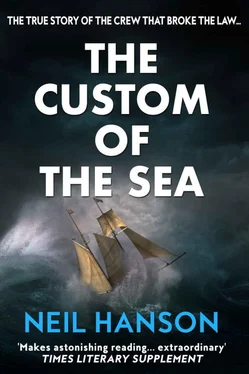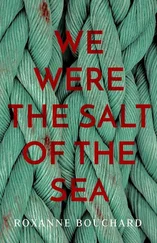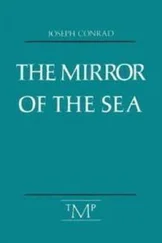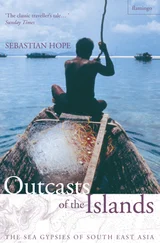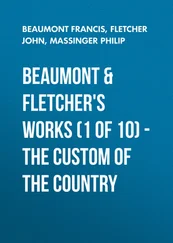At first Tom had refused to consider the idea, but the entreaties of his wife and the parlous state of his finances eventually persuaded him to accept, on the condition that any money over and above the cost of the defence should be used to pay for the education of Richard Parker’s sister Edith.
Financial aid also began to arrive from other sources. Broadsheet ballads were published and sold on the streets to raise funds and several yacht clubs also launched appeals and took collections for Tom and Stephens.
The Mignonette’s dinghy was still in Mr Buckingham’s warehouse at Upton Slip and the Falmouth News Slip urged readers to ‘see the Boat of the Yacht Mignonette at Buckingham’s and leave some coppers for the men’.
The Falmouth & Penryn Weekly Times also enlisted the support of its readers:
It appears that the seamen castaways are destitute and our friend Mr John Buckingham who has charge of the boat is prepared to show her to all people who will pay a small contribution for the benefit of these unfortunate men.
We are further gratified to find that Mr R. D. Patterson, a great New Zealand showman, will give a benefit night on Wednesday next at the Polytechnic Hall, so that the inhabitants of Falmouth will have an opportunity of showing their practical sympathy for distress, for which Falmouth has always been justly renowned. We have no doubt that an assembly of sympathizers will be present at the hall waiting to give ovation in the remembrance of the deliverance of these men whose sufferings are almost without a parallel and whose fortitude belongs to the men of the sea.
Mr Patterson’s attraction was a ‘Grand Diorama’ containing fifty scenes of New Zealand life on a canvas two thousand yards long. The paper later revealed that the benefit night ‘has resulted in a handsome donation for the benefit of the sufferers of the Mignonette’ .
Another West Country paper reported:
The small mahogany boat in which the men were drifting is still at Falmouth and during the last day or two has been visited by hundred of persons including many experienced mariners, all of whom expressed the greatest surprise that so many men could have existed at all in so frail a craft tossed about on the stormy billows, and how they could have lived at all in such weather as Captain Dudley and his companions experienced.
The boat has been very minutely examined but no traces of blood are discoverable. There are plenty of indications however that the boat was sadly knocked about. The public feeling at Falmouth and indeed throughout the rest of England is one of deep sympathy for the unhappy men.
Jack Want, the Mignonette’s owner in Sydney, also sent a donation to the defence fund. Although unable to forward the report he had prepared, which had been impounded as evidence, Tom had written to him outlining the events and hinting at some suitable reward for Captain Simonsen.
We were able to tell Captain Simonsen our sad tale but not before himself learning a little by his crew having the remainder of the body to throw out of the boat. I begged him to save the boat for me and am thankful he did so.
We were on board Moctezuma 38 days during the passage to Falmouth during which time Captain Simonsen gave us every possible attention. We were nothing but skin and bone at the time we came on board, but thanks to the treatment and kindness we received from that gentleman, we all have him to thank so much for recovering so far to our general health and the kindness we received, no words can express. Nothing we could ever do and give could repay him for past kindness. However I trust something may be done to keep him in remembrance of the poor souls he saved.
In addition to sending Simonsen a token of his appreciation, Want also sent Tom the hundred pounds he would have received had the Mignonette been safely delivered to Sydney. Want had the yacht insured for more than he had paid for it and was not out of pocket by the gesture, but it was still a generous act.
Tom and Stephens also sought to take the first steps towards earning their own living again by applying for the renewal of their Board of Trade certificates of competence. They had been lost with the Mignonette and without them they could find employment on a ship only as ordinary seamen.
Two Board of Trade officials approved the request, noting on the file, ‘I suppose they should have them,’ and ‘I see no reason for withholding them,’ but the request was referred to the Home Office for a final decision,
…as it is understood that both Mr Dudley and Mr Stephens, now out on bail, are still lying under the charge of having murdered one of the crew of the Mignonette, I am to request you to move Sir William Vernon Harcourt and cause them to be informed whether he sees any objection to the renewal of the certificates as requested.
Home Office officials feared that if the men had their certificates, it would give them an incentive to breach their bail and the home secretary decided the matter: ‘I think their certificates might not be renewed at least until the court has decided whether the men are guilty of murder.’
Brooks had none of the financial problems of his former shipmates. Although required as a witness at the assizes, he was free to return to sea in the interim, or resume work as a rigger at Fay’s Yard, but he preferred the offer of more remunerative employment in a travelling show. Several showmen had also approached Tom, offering him money to exhibit himself, but he turned them all down flat. Brooks had no such scruples. Billed as ‘The Cannibal of the High Seas’, he appeared all over the West Country and the south coast in a sideshow to a travelling fair amongst the bearded ladies and manacled ‘Wild Men’.
Unshaven and dressed in suitably distressed rags, Brooks posed in front of a crudely painted backdrop of the Mignonette’s dinghy adrift on the ocean. For the further edification of the paying customers, he devoured scraps of raw meat in a gruesome simulacrum of the ordeal he had endured. In addition to his wages and his keep, he was allowed half the proceeds from the souvenir postcards of himself that he sold.
The Mignonette’s dinghy also became an attraction in its own right. After being exhibited in Falmouth it was later sold to an Exmouth showman for fifty pounds. Although it was the genuine article, the dinghy was enhanced before being put on show. The existing marks on the cross-members and brass crutches for the oars were deepened to give them more prominence and bloodstains were added to heighten the audience’s vicarious thrill.
There was no shortage of paying customers wanting to see Brooks or the dinghy. The Victorians had a voracious appetite for the curious, ghoulish or criminal. Even after public hangings were outlawed, the Dead Houses, in which unidentified bodies scavenged from the rivers or harbours were displayed until claimed or buried in paupers’ graves, were always thronged with crowds eager for the macabre spectacle. Parties of members of polite Victorian society also amused themselves by touring the Bedlams — the hospitals for the insane — poking fun at the unfortunate occupants.
Penny ballads about natural and man-made disasters were hastily penned and hawked around the streets, and penny dreadful newspapers, such as the Illustrated Police News , achieved huge circulations on an uninterrupted diet of gruesome pictures and ghoulish copy celebrating crimes and disasters. The Mignonette case provided their illustrators with plentiful source material.
The proprietors of travelling freak shows were merely cashing in on this insatiable public appetite. They had evolved out of the annual country goose, horse and hiring fairs, held on holy days and holidays. Curiosities were often exhibited among the hucksters, whores, quack-medicine salesmen, travelling toothpullers, and the recruiters for King and country, pressing the King’s shilling on drunken farm boys.
Читать дальше
